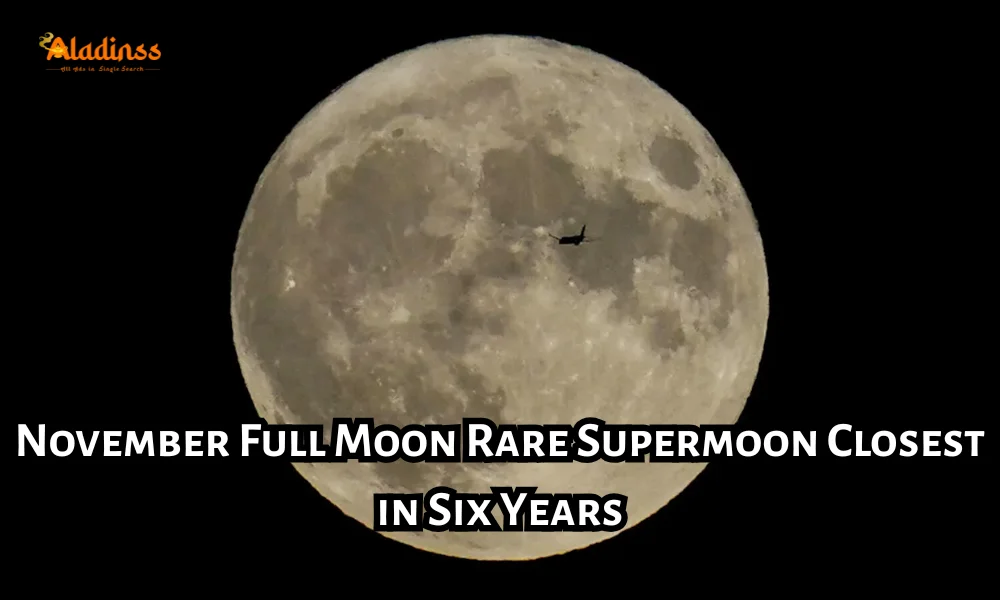November Full Moon Rare Supermoon Closest in Six Years

November Full Moon: Rare Supermoon Approaches Earth Closest in Six Years
Skywatchers around the world are gearing up for an extraordinary celestial display as the November full moon transforms into a stunning supermoon. This event, marking the second supermoon of 2025, brings the moon remarkably close to our planet about 357,000 kilometers away making it the nearest approach since 2019. Unlike ordinary full moons that brighten the night sky monthly, this supermoon promises to dazzle with its amplified size and glow, drawing astronomy enthusiasts outdoors for a once-in-a-lifetime view.
What elevates this November full moon to supermoon status? It's the moon's elliptical orbit, which occasionally aligns its closest point, called perigee, with the full phase. This alignment results in a lunar disk that appears roughly 14 percent larger and 30 percent brighter than average, according to experts at NASA. As the moon hurtles toward perigee tonight, it reflects sunlight more intensely against Earth's atmospheric backdrop, creating a spectral glow that's hard to ignore. For those in urban areas plagued by light pollution, this is a prime chance to reconnect with the cosmos.
The allure of this supermoon extends beyond its visual spectacle. Historically, full moons like the November beaver moon have inspired folklore and guided seasonal activities. Named for the industrious beavers building dams before winter, this moon signals the transition into colder months. In 2025, with three supermoons dotting the calendar October's harvest supermoon, November's beaver, and December's cold moon this event stands out as the year's most intimate lunar encounter.

Also Read: Antoine Griezmanns Ex Coach Sentenced To Six Years In Jail For Sexually Assaulting Minors
Understanding the Supermoon Phenomenon
A supermoon occurs when the moon's full phase coincides with perigee, the point in its 27.3-day orbit where it's nearest to Earth. This isn't a new discovery; ancient astronomers noted these variations, but the term "supermoon" gained popularity in the 1970s through astrologer Richard Nolle. Scientifically, the moon's average distance is 384,400 kilometers, but during perigee, it dips as low as 356,500 kilometers like tonight's approach. This proximity amplifies tidal forces slightly, though myths linking supermoons to disasters like earthquakes remain unsubstantiated by data from seismologists.
In 2025, this November supermoon edges out the others in closeness, surpassing October's by about 50,000 kilometers. NASA highlights that the moon will span 0.55 degrees across the sky, compared to a typical 0.5 degrees, offering a subtly grander vista. For photographers, this means capturing a luminous orb that dominates horizons, especially at moonrise when atmospheric refraction adds a warm hue.
Beyond aesthetics, supermoons remind us of our planet's dynamic relationship with its satellite. The moon stabilizes Earth's axial tilt, ensuring predictable seasons, and its gravitational pull sculpts coastlines over eons. Tonight's event, visible globally from dusk, underscores why stargazing fosters wonder and scientific curiosity alike.
Why This November Supermoon Stands Out in 2025
Calendars mark three supermoons for 2025, but November's beaver moon claims the spotlight as the closest full moon to Earth in six years. Last seen at this proximity in 2019, it revives memories of that year's viral sky shows. This year, the moon's perigee aligns precisely at 8:19 a.m. EST on November 5, with peak fullness lingering into evening hours across time zones. In regions like North America and Europe, expect rise times around sunset, framing silhouettes against twilight skies.
Astronomers dub it a "spectral event" due to enhanced brightness from scattered sunlight. The moon's surface, pockmarked by craters formed billions of years ago, reflects this light vividly, appearing 30 percent more radiant. For casual observers, no telescope is needed; the naked eye suffices, though binoculars reveal subtle details like the Sea of Tranquility, site of Apollo 11's landing.
Comparatively, a standard full moon at apogee the farthest point seems diminutive by contrast. This November's event, 14 percent wider, evokes a sense of scale, prompting reflections on space exploration. With NASA's Artemis program eyeing lunar returns, such nights inspire the next generation of dreamers.
- Proximity Record: At 357,000 km, it's 27,000 km closer than average perigee.
- Brightness Boost: Up to 30% more luminous, outshining city lights.
- Size Illusion: Appears 14% larger, ideal for horizon photography.
- Tidal Nuance: Minor high tides, safe for coastal viewing.
Best Ways to Experience the Beaver Supermoon
To fully appreciate this November supermoon 2025, scout locations with unobstructed eastern horizons think beaches, fields, or hilltops. Light pollution maps from apps like Dark Sky Finder pinpoint optimal spots. Time your outing for moonrise; the "moon illusion" makes it loom enormous against earthly backdrops, a psychological trick amplifying its grandeur.
Preparation is key: Dress warmly as November evenings chill, and use a tripod for steady shots. Apps such as Stellarium or The Photographer's Ephemeris predict exact rise azimuths, aiding compositions. Families can turn it into an educational outing, discussing moon phases or sharing beaver moon lore tales of Native American tribes tracking seasons via lunar cycles.
Safety first: Avoid driving distracted by the sky, and check weather for clear vistas. In southern hemispheres, the moon hangs low post-sunset, offering inverted views. Globally, this supermoon unites observers, from urban rooftops to remote observatories, in shared awe.
The Science Behind the Spectacle
Delving deeper, the supermoon's mechanics stem from orbital mechanics. Earth's gravity warps the moon's path into an ellipse, with eccentricity causing perigee-apogee swings. Full moons happen when sun, earth, and moon align oppositionally every 29.5 days the synodic month. When this syncs with perigee, voila: supermoon.
Quantitatively, light travel time shortens by milliseconds during closeness, imperceptible but fascinating. Gravitationally, tides rise 20-30% higher, influencing marine life rhythms. Ecologists note nocturnal animals like owls become more active under brighter beams, altering ecosystems subtly.
NASA's Lunar Reconnaissance Orbiter data confirms the moon's slow recession 3.8 cm yearly meaning future supermoons will be rarer. Tonight's proximity, a relic of formation 4.5 billion years ago from a Mars-sized impact, connects us to cosmic origins.
Cultural and Historical Echoes of the Beaver Moon
The beaver moon's moniker traces to Algonquian tribes, who observed beavers' pre-hibernation frenzy under its light. European settlers adopted it, weaving into harvest festivals. In medieval Europe, similar "frost moons" heralded solstice preparations, blending pagan rites with Christian calendars.
Globally, equivalents abound: Japan's "jugetsu" evokes chrysanthemum blooms, while Hindu traditions link it to Kartik Purnima rituals. Modern pop culture amplifies via social media, where #Supermoon trends spike, fostering virtual watch parties.
Astrologers view this Aries supermoon as energizing, urging bold actions. Whether scientific or spiritual, it unites humanity under one sky, echoing Carl Sagan's "pale blue dot."
Myths, Facts, and Future Lunar Wonders
Debunking tall tales: No, supermoons don't trigger werewolves or tsunamis studies from USGS show no correlation. Fact: It's the third-brightest object post-sun and Venus. Looking ahead, December's cold supermoon follows, then a 2026 quartet.
For budding astronomers, track via International Astronomical Union calendars. This November supermoon 2025 isn't just a sight; it's a portal to understanding our universe's elegance. Step outside tonight let the moon's gentle pull remind you of night's quiet magic.
As we conclude, remember: In an era of screens, reclaiming the sky nurtures perspective. Share photos, stories, and awe this beaver supermoon deserves it. With clearer nights ahead, 2025's lunar lineup promises more marvels.
Comment / Reply From
No comments yet. Be the first to comment!











